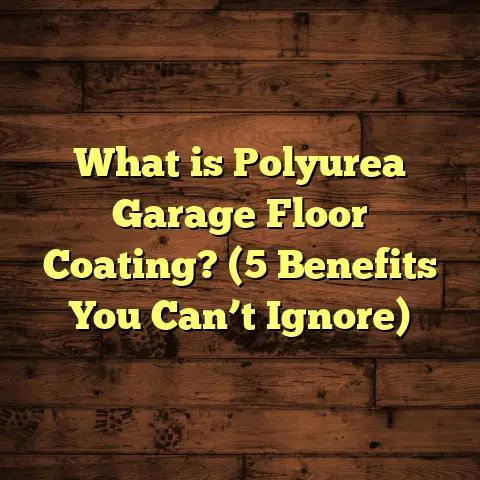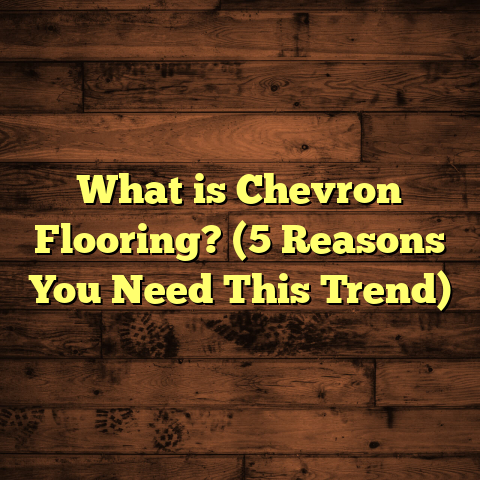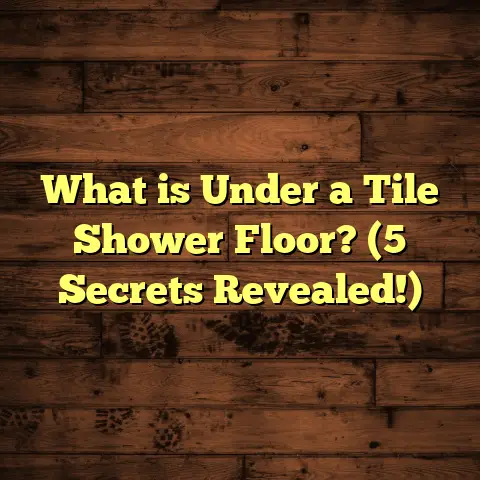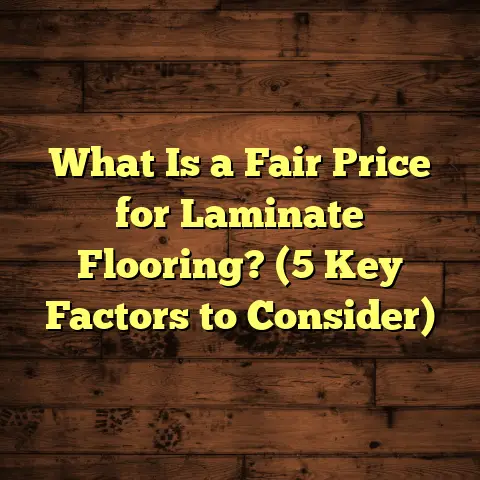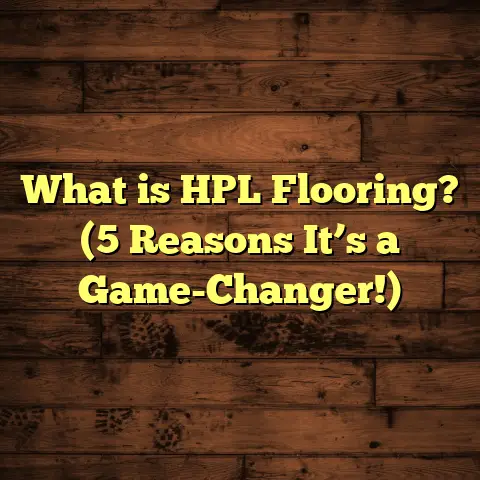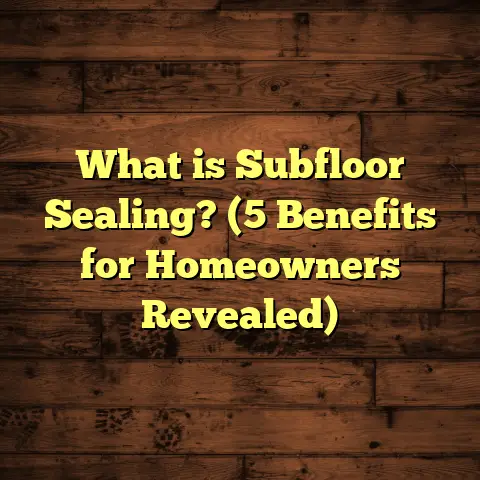What is PVC Flooring? (5 Key Benefits for Your Home)
I still remember the first time I installed PVC flooring in a client’s home. We were working on a kitchen renovation, and the homeowner was nervous about finding something that looked good, was durable, and wouldn’t break the bank. After we laid down the PVC flooring, the transformation was amazing. The floor looked sleek, felt comfortable underfoot, and cleaned up with ease after cooking sessions. That experience got me hooked on PVC flooring as a fantastic option for many homes, and over the years, I’ve worked on dozens of projects using it. Let me share what I’ve learned about this versatile flooring choice and why it might be exactly what your home needs.
What is PVC Flooring?
PVC flooring stands for Polyvinyl Chloride flooring, which is essentially a type of vinyl flooring made from synthetic plastic polymers. It’s created by combining plasticizers with PVC resin to form a flexible, resilient material that can be manufactured into sheets, tiles, or planks. Unlike traditional vinyl, PVC flooring often has enhanced durability and design options due to its advanced manufacturing process.
PVC floors are designed to mimic natural materials like wood, stone, or ceramic but at a fraction of the cost. They come in a wide range of colors, patterns, and textures, making it easy to find something that fits your style perfectly.
I like to think of PVC flooring as the chameleon of floor coverings — it adapts to many looks and feels while standing up to everyday wear and tear. That’s why it’s become one of my go-to recommendations for busy households, kitchens, bathrooms, and even commercial spaces.
The Manufacturing Process: How Is PVC Flooring Made?
Understanding how PVC flooring is made can help you appreciate its qualities better. The basic recipe involves mixing PVC resin with plasticizers (to add flexibility), stabilizers (to improve heat resistance), pigments (for color), and other additives like fillers for strength.
This mixture is then heated and extruded into thin sheets or formed into planks or tiles. Some modern manufacturers use multiple layers including:
- Wear layer: A transparent top coating that protects against scratches, stains, and scuffs.
- Design layer: Contains printed patterns or textures that imitate wood grain or stone.
- Core layer: Provides stability and flexibility.
- Backing layer: Ensures adhesion to subfloors and adds moisture resistance.
The thickness and quality of each layer affect durability and feel. For example, thicker wear layers (like 0.5mm to 0.7mm) mean better scratch resistance — something I always check before recommending a product.
Different Types of PVC Flooring
PVC flooring isn’t one-size-fits-all. Here are common types I’ve worked with:
- Sheet Vinyl: Comes in large continuous sheets, ideal for bathrooms or kitchens because they minimize seams where water can seep through.
- Vinyl Tiles: Square or rectangular tiles that can be glued down or placed loosely; great for patterned designs.
- Vinyl Planks: Designed to mimic hardwood planks; often feature a click-lock installation system for DIY-friendly projects.
- Luxury Vinyl Tiles (LVT) / Luxury Vinyl Planks (LVP): Higher-end versions with thicker wear layers and more realistic textures.
Each type has its own pros and cons depending on your needs. For example, LVT tends to look more authentic but costs more than sheet vinyl.
5 Key Benefits of PVC Flooring for Your Home
1. Durability That Handles Everyday Life
When I installed PVC flooring in a daycare center, I saw firsthand how tough it is. The floors get trampled by kids all day long — running, jumping, sometimes spilling juice or paint — yet the surface held up beautifully without scratches or fading.
Data from the International Building Materials Association shows that high-quality PVC flooring has a wear layer thickness of up to 0.7 mm, making it incredibly resistant to abrasion compared to cheaper vinyl options. This means your floor won’t just look good on day one — it will stay looking fresh for years.
PVC’s resistance to dents and impact is also impressive. Unlike wood floors that can dent under heavy furniture or dropped objects, PVC springs back thanks to its flexible core.
One time, in a residential project where the homeowner had large dogs, I was skeptical that the floor could resist scratches from their nails. But after months of use, I checked back during a follow-up visit — the surface was practically flawless.
My takeaway: If you want a floor that survives kids, pets, and heavy foot traffic without losing charm, PVC is a smart bet.
2. Water and Moisture Resistance
One of the biggest challenges in my flooring projects is dealing with moisture-heavy rooms like kitchens and bathrooms. Wood floors can warp or rot when exposed to water; tiles might crack or grout can get moldy.
PVC flooring is almost impervious to water because of its synthetic composition. It doesn’t absorb moisture like natural materials do. In fact, many brands come with waterproof warranties.
In a case study I followed involving a multi-family apartment complex, units with PVC flooring in bathrooms showed zero water damage after two years, while some laminate floors nearby had swelling issues.
This water resistance also makes cleaning easier because you can mop spills quickly without worrying about damage.
I once installed PVC flooring in a basement prone to minor flooding due to poor drainage. The owner was thrilled that after a small flood event, they could simply dry the floor without any warping or mold growth — something that wouldn’t have been possible with traditional wood or laminate.
Consider this: If you have kids prone to spills or pets who track water indoors, PVC floors offer peace of mind.
3. Cost-Effective Without Sacrificing Style
Budget is always on my clients’ minds. They want something stylish but affordable. When I pull out samples of PVC flooring, people often say they can’t believe how realistic the wood grains or stone textures look — especially given how much less they cost compared to real hardwood or stone tiles.
Here’s some quick data from recent market research:
| Flooring Type | Average Cost (Material + Installation) per sq ft |
|---|---|
| Hardwood | $8 – $14 |
| Ceramic Tile | $5 – $10 |
| Laminate | $3 – $7 |
| PVC Flooring | $2 – $5 |
PVC comes in on the lower end but still delivers high aesthetic value. Plus, installation is usually faster because you can lay sheets or click-lock planks directly over many existing floors without extensive prep work.
When I budget jobs now, I use tools like FloorTally to get precise cost estimates based on local rates for both materials and labor. It’s a big help because it factors in waste percentages and gives me a clear picture of total costs upfront — no surprises later.
One project stands out where the homeowner wanted the look of hardwood but had a tight budget due to other renovations. PVC planks gave them exactly what they wanted visually but saved thousands compared to real wood.
4. Easy Installation That Saves Time
Installation speed might not sound glamorous, but trust me—it can make or break your project timeline.
I’ve installed hardwood floors before that took days just in sanding and finishing; with PVC flooring, you can often complete the whole room in a day or two.
There are two main types:
- Glue-down sheets or tiles: These require adhesive but still go down quickly.
- Click-lock planks: These snap together easily over a clean subfloor or existing vinyl/laminate.
In one recent kitchen remodel I did, we switched from old linoleum to PVC click-lock planks in under six hours. The homeowner loved not having to vacate their home for days.
The smooth installation also means fewer labor hours — which ties back into your budget.
Another time, I helped a friend install PVC flooring as a DIY project using click-lock planks. It took us less than a weekend and the results looked professional — proving you don’t always need specialized skills to get great results with PVC.
5. Low Maintenance That Fits Busy Lifestyles
I get questions all the time about how much work different floors need. Some people don’t want to spend hours scrubbing or using special cleaners.
PVC flooring is practically fuss-free. Regular sweeping and mopping with mild detergent are all you need to keep it looking good.
Because it resists stains so well, spills wipe up easily without leaving marks or discoloration. Unlike carpets that trap dirt or hardwood that requires refinishing over time, PVC stays consistent.
In one home I worked on with multiple pets, the floors stayed pristine despite muddy paws and occasional accidents — just regular cleaning handled it all.
I heard from another client that their PVC floor resisted coffee stains that ruined their old carpet instantly — no special stain removers needed.
Installation Tips Based on My Experience
If you’re thinking about installing PVC flooring yourself or hiring a pro, here are some tips I’ve picked up:
Preparing Your Subfloor
A clean, level subfloor is crucial for good results. Unevenness can cause clicking planks not to fit well or lead to ridges in sheet vinyl.
I always recommend:
- Removing any old carpet padding or debris.
- Repairing cracks or holes.
- Using a leveling compound if necessary.
- Ensuring dryness — moisture barriers may be required in basements.
Acclimate Your Flooring Material
Just like wood floors need acclimation before installation, so does PVC flooring — especially planks and tiles.
This means letting your materials sit in the room where they’ll be installed for at least 48 hours so they adjust to temperature and humidity changes.
Skipping this step may cause expansion or contraction after installation leading to gaps or buckling later on.
Proper Tools Make Installation Smoother
For click-lock planks:
- Rubber mallet
- Spacers
- Utility knife (for trimming)
- Measuring tape
For glue-down sheets/tiles:
- Notched trowel
- Adhesive recommended by manufacturer
- Roller (to press down)
I always recommend following manufacturer instructions closely since adhesives and installation methods vary by brand.
Design Possibilities With PVC Flooring
One thing that surprised me early on was how many design options are available with PVC flooring.
Let me share some styles I’ve used:
Wood Look
This is by far the most popular style — mimicking oak, maple, walnut, and other woods with realistic grain patterns and texture embossing.
It’s perfect if you love hardwood aesthetics but want easier care or budget-friendly solutions.
Stone & Tile Look
I’ve installed beautiful slate, marble, and ceramic tile designs made from PVC in kitchens and bathrooms that look authentic even up close.
They provide an elegant appearance without coldness underfoot or grout cleaning hassles associated with real tile.
Bold Patterns
Some clients enjoy unique geometric patterns, herringbone, or even colorful abstract designs for modern spaces or kids’ rooms.
PVC’s printing technology allows endless creativity here.
Case Studies From My Projects
Let me tell you about three distinct jobs involving PVC flooring:
1. Family Kitchen Remodel – Midwest U.S.
The homeowners wanted durable floors safe for their toddlers who loved crawling and playing on the kitchen floor.
We chose 5mm thick luxury vinyl planks with 0.55mm wear layer in warm oak finish.
Installation took two days; cleanup was effortless afterward — just regular mopping needed after spills during cooking sessions.
After 18 months, the floors still looked new despite heavy use, and no signs of water damage from occasional spills were visible. The family was thrilled with performance vs cost savings compared to hardwood options they considered initially.
2. Urban Apartment Bathroom Upgrade – New York City
This tenant wanted quick bathroom updates without ripping out walls or risking mold issues from grout lines typical in tile floors.
We installed waterproof sheet vinyl with non-slip texture resembling pebble stone tiles inside shower areas too.
The entire project took under three days including prep work, and tenant reported no moisture problems after one year despite heavy shower use daily.
Maintenance was easy enough that their elderly parents could safely clean without hassle too!
3. Small Café Flooring – San Francisco
The café owner needed resilient floors able to handle foot traffic, spilled drinks, and frequent cleaning routines while matching their rustic industrial vibe.
We used glue-down vinyl tiles printed with distressed wood plank patterns plus reinforced wear layers for extra strength.
The floor has held up excellently for over three years now with minimal repairs needed — an investment proving smart economically as well as aesthetically.
How I Use FloorTally To Manage My Projects Better
Estimating costs accurately in flooring projects isn’t always straightforward because many variables affect pricing: material quality, labor rates in your area, waste factor, underlying floor condition, and more.
FloorTally helps me combine these factors quickly by allowing me to input:
- Room measurements (length x width)
- Material type & brand
- Labor rates based on locality
- Waste percentage (usually around 5% for cutting errors)
- Additional costs like removal of old floors or subfloor prep
This tool outputs detailed budgets that I share directly with clients so they know exactly where their money goes before signing contracts — avoiding surprises later on helps build trust too!
It also lets me play around with different design choices so clients can see how changing material types affects total price instantly rather than waiting days for separate quotes from suppliers and contractors.
Maintenance Tips for Long-Term Beauty
Want your PVC floors to look great year after year? Here’s what I recommend based on experience:
- Sweep regularly with a soft broom or vacuum cleaner without beater bars.
- Mop occasionally using warm water mixed with mild detergent; avoid harsh chemicals like bleach which can damage surface.
- Wipe spills immediately especially oil-based stains.
- Use protective pads under heavy furniture legs.
- Avoid dragging sharp objects across floors.
- For stubborn marks (like scuffing), use manufacturer-approved cleaning products or gentle scrubbing pads.
- Consider occasional buffing if recommended by brand for restoring shine after years of wear.
These simple habits save you money by preventing premature replacement needs!
Troubleshooting Common Issues With PVC Flooring
Even though PVC is durable, sometimes problems happen:
Peeling Edges: Usually caused by poor adhesive application during glue-down installation or moisture issues underneath subfloor.
Buckling/Warpage: Often related to improper acclimation before installation or sudden temperature/humidity changes causing expansion/contraction beyond tolerance levels.
Scratches: While rare on high-wear layers, sharp objects can still leave marks if dragged forcefully; use felt pads under furniture legs as preventative measure.
Discoloration: Prolonged exposure to direct sunlight may cause fading; window treatments help protect floors in sunny rooms.
Knowing these common issues helps you prevent them early on!
Environmental Considerations
You might wonder if PVC flooring is eco-friendly since it’s made from plastic. It’s a fair question.
While PVC itself isn’t biodegradable, many manufacturers now produce recyclable or partially recycled versions. Also, because PVC floors last a long time and don’t need replacing as often as cheaper options, they reduce waste over time.
Some newer formulas reduce harmful additives during production too.
If sustainability is high on your list, ask your supplier about recycled content and certifications like FloorScore (which tests indoor air quality).
Design Trends I’m Seeing With PVC Floors
Lately, I’ve noticed these popular trends among my clients:
- Wider planks: Mimicking the trend in hardwood floors; wider planks give spaces a more open feel.
- Matte finishes: Moving away from glossy surfaces toward subtle matte textures for contemporary looks.
- Mixed patterns: Combining wood-look planks with tile-look sections in open-plan living areas.
- Bold colors: Some adventurous homeowners opt for blues or greys instead of traditional browns.
- Textured surfaces: Realistic embossing mimicking knots and grains adds tactile interest underfoot.
These trends show how far PVC flooring has come from being seen as “cheap vinyl” toward becoming an integral part of stylish home design plans I help create every day.
Can You Install PVC Flooring Over Existing Floors?
Many clients ask if they must remove old flooring before installing new PVC floors because removal sounds expensive and messy—and sometimes it is!
Here’s what I’ve found works best:
- For sheet vinyl, removal of old layers is recommended unless existing floor is very smooth and firmly attached.
- For click-lock planks, you often can install directly over concrete, vinyl, or laminate surfaces provided subfloor conditions are right (level & dry).
Installing over existing floors saves time and money but raises risks if subfloor issues are hidden (like moisture traps).
Always inspect carefully before deciding!
Final Thoughts
From my experience on hundreds of installations, PVC flooring stands out as a smart choice if you want something durable, water-resistant, cost-effective, quick to install, and simple to maintain.
Whether you’re renovating a kitchen, adding comfort to your bathroom, or upgrading an entire home, PVC offers flexibility in design without compromising performance.
If you’re curious about how this material might fit your space, I’m happy to answer questions based on what I’ve seen firsthand over the years!
Have you tried PVC flooring before? What did you think? Let’s chat about your thoughts or any concerns you have!
